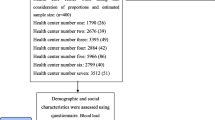Abstract
Blood lead levels of 253 Delhi children were estimated by dithizone method. In 82 (controls) children with no symptoms mean blood lead level was 9.6 μg/dl (±SD 6.8: median 10 μg); only 6 had high levels between 30–33 μg/dl. In 88 children with pica, the mean blood lead level was 23.0 μg/dl (±SD 13.82; median 17 μg) which was significantly higher than the control; 26 had high levels between 30–92 μg/dl. Sixteen children with pica and surma- use and 46 children suspected of lead poisoning showed lead level patterns like the pica group. However, 21 surma-using children without pica resembled the control group. Children with pica were significantly more anemic than the controls and showed higher prevalence of abdominal-neurological symptoms. Because, in India, blood lead cannot be estimated in most of the hospitals, it is suggested that children with severe pica, anemia, abdominal-neurological symptoms and exposure to surma or lead, be suspected of lead poisoning, kept in lead-free environment with corrected nutrition, and be given a short cautious therapeutic trial with oral penicillamine.
Similar content being viewed by others
References
Mahabharat Gorakhpur: Geeta Press, 1988, Vol. 3Udyogaparva, Adhyaya 39, Shloka 80; 2168.
Jaggi OP.Dawn of Indian Technology, Vol. 1, chapter 10: Metallargy, Delhi: Atma Ram & Sons; 1969, 106–123.
Cchandogya Upanishad. Prapathak 4, Khand 17, line 7. In: Swami Satyanand, ed.Ekaadshopanishadsangraha, 5th ed, New Delhi: Swami Satyanand Charitable Trust, 1976; 198.
Yajurveda-Krishna-Taittireeya Samhita-Kaand 4, Prapahak 7, Rudraadhyaaya Chamak Section, Anuwaak 5. In: S Chitrao, ed.Vaidic, Suktapaath, Pune: Bhaarateeya Charitrakosha Mandal, 1975; 105.
Harvey SC. In: Goodman LS, Gilman A, ed.The Pharmacological Basis of Therapeutics, 4th ed. New York: Macmillan Publishing Company, 1970: 977–986.
Borkar DB ed.Sushrut Samhitaa (about 600 BC) Pune: Y.G. Dikshit Booksellers, 1934; 447–448.
Shree Gulab Kunwerba Ayurvedic Society ed,Charak Samhitaa (about 1000 BC). Jamnagar: 1949; a-1040; b-1331; C-72.
Garde GK, ed.Waagbhata’s Ashtaangrhudaya (about 400 A. D.) 4th Edition, Pune: 1956; 7.
Moncrieff AA, Koumides OP, Clayton Barbara E.et al. Lead poisoning in children.Arch dis Child 1964; 39: 1–13.
Basu Nandita, Gogte ST, Jain SC et al. Lead in Delhi environment.Indian J Industrial Med 1990; 36: 5–13.
Quazi QH, Madahar DP. A simple rapid test for lead poisoning.J Pediatr 1971; 79: 805–808.
Hasan MZ, Pande SP. Comparative study on methods of determination of lead in drinking water.Indian J Environ Health 1978; 20: 232–235.
Khandekar RN, Radha Raghunath, Mishra UC. Levels of lead, cadmium, zinc and copper in the blood of an urban population.Sci Total Environ 1987; 66: 185–191.
Bicknell J, Clayton BE, Delves HT. Lead in mentally retarded children.J Ment Defic Res 1968; 12: 282–293.
Manser WWT. Surma—A toxic cosmetic.J Pak Med Assoc 1989; 39: 196.
Graef JW, Lovejoy FH. In: Braunwald Eugene ed.Harrison’s Principles of Internal Medicine. 11 th ed; New York: Mc Graw-Hill Book Company, 1987; 852–853.
Singal GM, Gatrad AR, Howse PM et al. Blood lead, ethnic origin and lead exposure.Arch Dis Child 1988; 63: 973–975.
Attenburrow AA, Campbell S, Logan RW et al. Surma and blood lead levels in Asian children in Glasgow.Lancet 1980; 1: 323.
Singh S, Singhi Sunit. Severe lead intoxication in a family caused by use of residential premises for battery manufacture.Indian Pediatr 1989; 26: 718–720.
Rabinowitz MB, Needleman HL. Temporal trends in the lead concentrations of umbilical cord blood.Science 1982; 216: 1429–1431.
Annest JL, Pirkle JL, Diane Makuc et al. Chronological trend in blood lead levels between 1976 and 1980.N Engl J Med 1983; 308: 1373–1377.
Author information
Authors and Affiliations
Rights and permissions
About this article
Cite this article
Gogte, S.T., Basu, N., Sinclair, S. et al. Blood lead levels of children with pica and surma use. Indian J Pediatr 58, 513–519 (1991). https://doi.org/10.1007/BF02750933
Published:
Issue Date:
DOI: https://doi.org/10.1007/BF02750933




